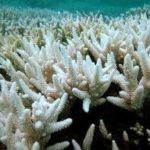In the last 100 years atmospheric carbon dioxide has risen to about 30 percent above pre-industrial levels.
At the same time, the pH of the oceans has fallen by 0.1 unit to 8.1. A pH is a measure of acidity, the lower the number the more acid a body of liquid is.
The Intergovernmental Panel on Climate Change (IPCC) predicts that ocean pH may fall another 0.3 units by the end of the century to 7.8.
When seawater becomes too acid, corals and shrimp-like plankton at the bottom of the food chain cannot survive.
Carbon emissions are acidifying oceans at a faster rate than at any time in the past 300 million years, raising the prospect of ecological catastrophe in decades to come.
New research has shown that even during periods of past mass extinctions the ocean acidity rate nowhere near matched what it is is today.
The knock-on effects can lead to widespread mass extinction of marine species, and is believed to have done in the past.
The study should that levels of carbon dioxide has risen at such a rate that it could cause ecological warfare for marine species.
Scientist looked to the past to get a better picture of what is now happening in the oceans.
Hundreds of previous studies of climate change events in the past 300 million years were reviewed.
On only one occasion did ocean acidity increase even remotely as fast as it is today, the Palaeocene-Eocene Thermal Maximum (PETM) around 56 million years ago.
In the early 1990s scientists discovered that during this period, a mysterious doubling of carbon dioxide concentrations in just 5,000 years raised global temperatures by 6 degree Centigrade.
There was also clear evidence of the effects of ocean acidification. A brown layer of mud was all that remained of carbonate plankton shells dissolved by the acidic waters.
As many as half of all species of benthic foraminifers, a group of single celled organisms dwelling at the bottom of the oceans, disappeared.
Although no other major extinctions are known to have occurred during the PETM, the event dramatically changed the ecological landscape.
Today, the oceans are acidifying at a rate at least 10 times faster than occurred then. However, it may take decades before the effects on marine life show themselves, said the scientists.
Professor Andy Ridgwell, from the University of Bristol, a member of the international research team, said: ‘The geological record suggests that the current acidification is potentially unparalleled in at least the last 300 million years of Earth history, and raises the possibility that we are entering an unknown territory of marine ecosystem change.
‘Although similarities exist, nothing in the last 300 million years parallels the rates of future projections in terms of the disrupting of ocean carbonate chemistry, a consequence of the unprecedented rapidity of CO2 (carbon dioxide) release currently taking place.’
Laboratory studies have shown that lower pH levels can harm a range of marine life, from reef and shell-building organisms to the tiny snails favored by salmon.
In ocean pockets acidified by underwater volcanoes venting carbon dioxide, scientists have seen alarming signs of what may be to come.
One study of coral off Papua New Guinea, published in the journal Nature Climate Change last year, showed that when pH dropped to 7.8 reef diversity fell by up to 40 percent.
Dr. Christopher Langdon, from the University of Miami, US, a co-author of the Papua New Guinea study, said: ‘It’s not a problem that can be quickly reversed. Once a species goes extinct it’s gone forever.’
Dr. Barbel Honisch, from Columbia University in New York, US, who led the new research, said: ‘What we’re doing today really stands out.
‘We know that life during past ocean acidification events was not wiped out – new species evolved to replace those that died off.
‘But if industrial carbon emissions continue at the current pace, we may lose organisms we care about – coral reefs, oysters, salmon.’

